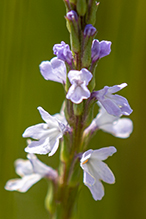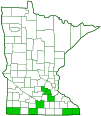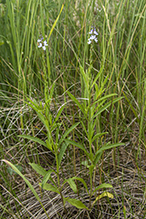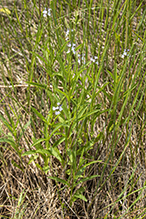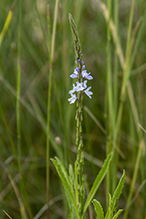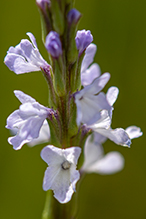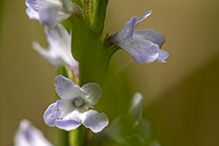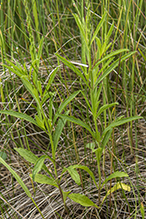narrow-leaved vervain
(Verbena simplex)
Conservation • Description • Habitat • Ecology • Use • Distribution • Taxonomy
Conservation Status |
|
|||||||
| IUCN Red List | not listed |
|||||||
| NatureServe | NNR - Unranked S3 - Vulnerable |
|||||||
| Minnesota | Special Concern |
|||||||
Description |
||
Narrow-leaved vervain is a 4″ to 27½″ (10 to 70 cm) tall, erect, perennial forb with narrow leaves and a spiked inflorescence. It grows in full sun in moderately dry to dry soil in upland prairies, hill prairies and old fields; on roadsides and railroad rights-of-way; and in other open, disturbed areas. It occurs in the United States from New Hampshire to Minnesota south to Texas and Florida, and in adjacent Canadian provinces. In Minnesota, where it is at the northwestern extent of its range, it has been recorded in only five counties. In two of those counties, the records are historical, and it is now presumed to be locally extinct (extirpated). It is listed as a special concern species in both Minnesota and Wisconsin. There may be several stems that are erect to strongly curved up from the base (ascending) or just a single erect stem. The stems are moderately or strongly four-angled and are sparsely to moderately covered with straight, strongly ascending hairs. They are usually unbranched below the inflorescence. The leaves are opposite, unlobed, narrowly lance-shaped, inversely egg-shaped, or linear, 1¼″ to 4″ (3 to 10 cm) long, and up to ⅝″ (15 mm) wide. They are stalkless or on a short leaf stalk, tapered at the base, and sharply or bluntly pointed at the tip. The upper and lower surfaces are sparsely covered with appressed hairs. The upperside appears wrinkled and is sometimes nearly hairless. The veins are conspicuously raised on the underside. The margins are coarsely toothed, more so or sometimes only toward the tip. The inflorescence is a single, 1½″ to 10″ (4 to 25 cm) long, 3 ⁄16″ to 5 ⁄16″ (5 to 8 mm) in diameter spike of many flowers at the end of the stem. The spike is moderately dense, the flowers strongly overlapping except at the base of the spike. Each flower is subtended by a single lance-shaped, ⅛″ to 3 ⁄16″ long, modified leaf (bract). The bract is usually shorter than the whorl of sepals (calyx) at the base of the flower. Each flower is about ¼″ in diameter. There are 5 sepals, 5 petals, 4 stamens, and 1 style. The sepals are green and are united into a ⅛″ (3 to 4 mm) long calyx tube with 5 pointed teeth. The petals are ⅛″ to ¼″ (4 to 6 mm) long. They are usually lavender or purple to white, or white tinged with blue, but rarely white. They are fused at the base into a slender, funnel-shaped tube then separated into 5 spreading lobes. The lobes are ⅛″ to ¼″ (4 to 6 mm) in diameter and blunt and rounded at the tip. Each flower produces a cluster of 4 greenish-brown to reddish-brown nutlets that are enclosed in the persistent calyx but are exposed at the tip. Each nutlet is narrowly oblong to narrowly oblong elliptic in outline and 1 ⁄16″ to ⅛″ long. They are ridged on the bottom and have a few cross ridges toward the top. |
||
Height |
||
4″ to 27½″ |
||
Flower Color |
||
Lavender or purple to white, or white tinged with blue, rarely white |
||
Similar Species |
||
Habitat |
||
Moderately dry to dry. Upland prairies, hill prairies and old fields; roadsides, railroads, and other open, disturbed areas. Full sun. |
||
Ecology |
||
Flowering |
||
Mid-June through mid-August |
||
Pests and Diseases |
||
|
||
Use |
||
|
||
Distribution |
||||
|
Sources |
|||
| 3/14/2023 | ||||
Nativity |
||||
Native |
||||
Occurrence |
||||
Common in eastern United States. Extremely rare in Minnesota |
||||
Taxonomy |
|||
| Kingdom | Plantae (Plants) | ||
| Subkingdom | Pteridobiotina | ||
| Phylum | Tracheophyta (Vascular Plants) | ||
| Class | Magnoliopsida (Dicots) | ||
Order |
Lamiales (Mints, Plantains, Olives, and Allies) | ||
Family |
Verbenaceae (verbena) | ||
| Tribe | Verbeneae | ||
| Genus | Verbena (vervain) | ||
| Section | Verbena | ||
| Series | Simplices | ||
Synonyms |
|||
| Verbena angustifolia | |||
Common Names |
|||
narrow-leaf vervain narrow-leaved vervain narrowleaf vervain simple verbena |
|||
Glossary
Ascending
Growing upward at an angle or curving upward from the base.
Bract
Modified leaf at the base of a flower stalk, flower cluster, or inflorescence.
Calyx
The group of outer floral leaves (sepals) below the petals, occasionally forming a tube.
Linear
Long, straight, and narrow, with more or less parallel sides, like a blade of grass.
Sepal
An outer floral leaf, usually green but sometimes colored, at the base of a flower.
Spike
The arrangement of an unbranched, elongated inflorescence with stalkless flowers that mature from the base toward the tip. In Cyperaceae, it also denotes a collection of one or a group of stalkless flowers, each subtended by scales, on a single inflorescence axis.

Slideshows |
||

Visitor Videos |
|||
Share your video of this plant. |
|||
| This button not working for you? Simply email us at info@MinnesotaSeasons.com. Attach a video, a YouTube link, or a cloud storage link. |
|||
Other Videos |
|||

Visitor Sightings |
|||||
Report a sighting of this plant. |
|||||
| This button not working for you? Simply email us at info@MinnesotaSeasons.com. Be sure to include a location. |
|||||
|
|||||
MinnesotaSeasons.com Sightings |
|||||

Created: 11/27/2019
Last Updated:
